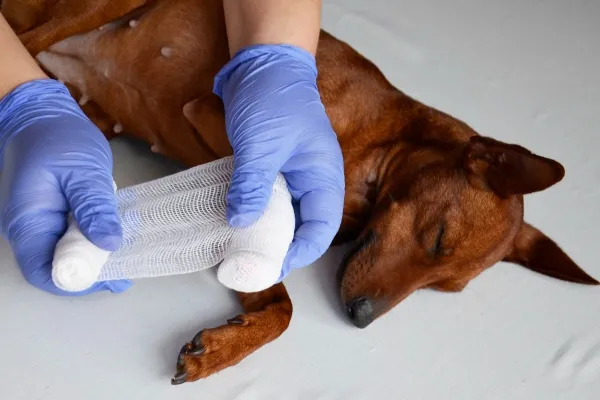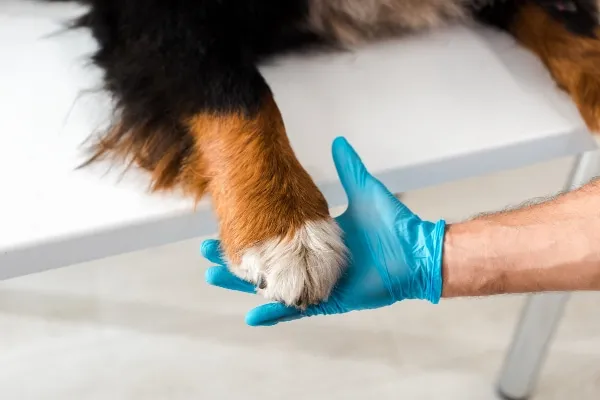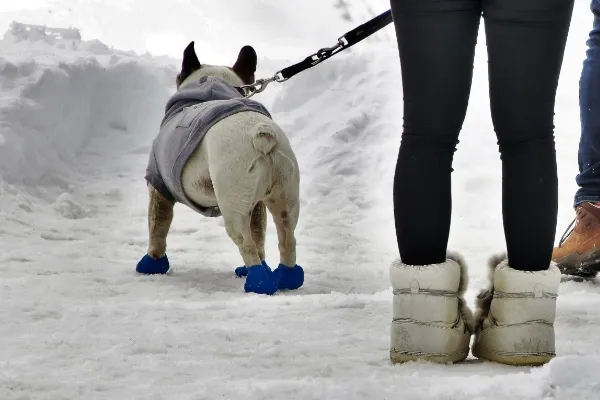A torn paw pad can be a distressing sight for any dog owner, causing immediate discomfort and hindering your furry friend’s ability to walk, run, and play. These resilient pads are critical for your dog’s mobility and protection, acting as natural shock absorbers and providing traction against various terrains. When they sustain an injury, particularly a tear, it’s not only painful but also opens the door to potential infections and complications. Knowing how to treat a dog’s torn paw pad quickly and effectively can make a significant difference in their recovery and overall well-being. This comprehensive guide, informed by veterinary expertise, will walk you through identifying, providing first aid for, and preventing torn paw pad injuries, ensuring your beloved companion gets back on their paws as soon as possible. Understanding the right steps to take is crucial for proper healing and to prevent further damage. If you’re looking for broader information on canine paw health, you might find our article on how to heal a dog’s torn paw pad equally insightful.
Understanding Your Dog’s Paw Pads: More Than Just Feet
Your dog’s paw pads are marvels of natural engineering, playing an indispensable role in their daily life. These thick, leathery cushions are not merely for walking; they serve multiple vital functions that contribute to your dog’s comfort and protection. Each step your dog takes, whether on a leisurely stroll or a vigorous run, relies on the integrity of these specialized structures.
The unique composition of paw pads provides essential cushioning, absorbing the impact from every stride. This shock absorption helps to reduce strain on the bones, joints, and ligaments of your dog’s feet and legs, safeguarding them from repetitive stress injuries. Furthermore, in conjunction with their toenails, the paw pads offer crucial traction, allowing your dog to navigate a variety of surfaces, from slippery indoor floors to rugged outdoor trails, with confidence and stability. They also provide a protective barrier against extreme temperatures, both hot and cold, and shield the delicate underlying tissues from abrasive or sharp objects. Understanding these functions highlights why a torn paw pad can be so debilitating, compromising your dog’s fundamental ability to move and explore.
 Dog with paw pads exposed, demonstrating their importance
Dog with paw pads exposed, demonstrating their importance
Identifying a Torn Paw Pad: Types of Injuries and Their Signs
Paw pads are constantly exposed to various elements, making them susceptible to a range of injuries. While the primary focus here is on torn paw pads, it’s important to understand the spectrum of injuries that can occur, as a tear often stems from or is related to other forms of trauma.
Common Paw Pad Injuries
- Cuts: These are frequently caused by sharp objects like broken glass, metal, or even sharp stones. A simple cut can range from superficial to deep, potentially affecting underlying tissues.
- Flaps or Tears: This is perhaps the most concerning type of “torn” paw pad. Flaps often occur when a sharp object slices horizontally across the pad, partially detaching a section of skin. They can also develop from untreated cuts that expand and tear further. These are generally more painful than simple cuts because each step pulls on the loose tissue, causing irritation and preventing healing.
- Puncture Wounds: Foreign objects such as splinters, thorns, nails, or foxtails can pierce the pad, creating a deep but sometimes small entry wound. These can be insidious, as the object may remain embedded, leading to infection.
- Burns: Extreme temperatures, both hot pavement in summer and icy surfaces or chemical ice melts in winter, can cause painful burns. Abrasive surfaces from prolonged activity can also lead to friction burns. Chemical burns from spilled caustic substances are another risk.
- Ingrown Toenails: Overly long nails can curl back and eventually puncture the paw pad, leading to an open wound that is prone to infection and severe pain. Regular nail trimming is essential to prevent this.
Signs Your Dog May Have a Torn Paw Pad
If your dog has sustained a paw pad injury, you might observe several tell-tale symptoms:
- Sudden Lameness or Limping: This is often the first and most obvious sign. Your dog may refuse to put weight on the affected paw.
- Crying Out: Pain when walking or when the paw is touched.
- Bleeding: Visible blood from the paw pad, which can range from minor oozing to more significant bleeding.
- Licking or Biting at the Paw: An intense focus on the paw, indicating discomfort or pain.
- Swelling: The paw or individual pad may appear swollen or inflamed.
- Discoloration: The paw pad or surrounding fur may look red, inflamed, or discolored.
- Visible Injury: A clear cut, tear (flap), puncture wound, or foreign object embedded in the pad.
If you notice any of these signs, a careful and prompt inspection of your dog’s paw is critical. For any type of paw injury, it’s always best to seek professional advice on how to treat a dog’s paw pad injury to ensure proper care.
 Dog with a cut paw pad showing signs of injury
Dog with a cut paw pad showing signs of injury
Immediate Action: First Aid for a Dog’s Torn Paw Pad
When faced with a torn paw pad, a calm and methodical approach to first aid is paramount. Your initial actions can greatly influence your dog’s comfort and the eventual outcome of the injury.
1. Prioritize Safety and Assess Your Dog’s Demeanor
Before anything else, ensure your safety and your dog’s. A dog in pain, even the most gentle pet, can act unpredictably. Comfort your dog and speak in a soothing voice. If your dog is severely painful, showing aggression, or unwilling to let you near the paw, do not attempt to examine or treat it yourself. Muzzling may be necessary, or it might be best to immediately seek veterinary care. If you feel it’s safe, proceed with the following steps.
2. Carefully Inspect the Paw
Gently lift and examine the affected paw. Look at the top, bottom, between the toes, and carefully at each paw pad. Try to identify the nature of the injury: Is it a cut, a flap (tear), a puncture, a burn, or is there a foreign object present? A clear understanding of the injury will guide your first aid.
3. Address Foreign Objects and Bleeding
- Removing Foreign Objects: If you see a small, superficial object like a sliver or a thorn that is clearly visible and easy to grasp, you may attempt to remove it with tweezers. However, if the object is deeply lodged, large, or appears to be near a blood vessel, nerve, or joint, do not attempt to remove it yourself. Removing it improperly could cause more damage or severe bleeding. In such cases, keep the object as stable as possible and seek immediate veterinary attention.
- Stopping Bleeding: For actively bleeding wounds, apply firm, even pressure with a clean cloth, gauze, or paper towel. Most minor cuts will stop bleeding within a few minutes. If the bleeding is profuse or continues steadily for 10-15 minutes, this indicates a more serious injury, and you should contact your veterinarian immediately for emergency care.
4. Clean the Wound
Once the bleeding has stopped, carefully clean the wound.
Use cool running water to rinse the paw pad. Cool water helps to wash away debris, reduce swelling, and can offer some pain relief, especially for burns. You can also use a mild antibacterial soap (like diluted dish soap, but rinse thoroughly) or a veterinary-approved antiseptic solution such as diluted chlorhexidine or povidone-iodine (Betadine) to help disinfect the area and prevent infection. Be gentle, as the area will be tender. Expect some slight re-bleeding during cleaning; simply apply pressure again if needed.
5. Apply a Protective Bandage
Bandaging is crucial to keep the wound clean, protect it from further injury, and contain any applied medication. If you don’t have proper bandaging supplies, a clean towel or T-shirt can serve as a temporary wrap until you reach the vet.
For proper bandaging:
- Place a non-stick sterile gauze pad directly over the wound.
- Apply an antibacterial ointment (e.g., Neosporin without pain relief, or vet-prescribed ointment) to the gauze if recommended by your vet or for minor injuries.
- Wrap the paw with self-adhering bandage material (like vet wrap) or gauze, making sure to include the paw and extending slightly up the leg.
- Crucially, ensure the bandage is not too tight. You should be able to comfortably insert one to two fingers into the top of the bandage. A bandage that is too tight can cut off circulation, leading to severe complications. Watch for signs like swollen toes (if they are exposed), coolness to the touch, or discoloration, which indicate the bandage is too tight. Proper bandaging is key to preventing further complications and supporting recovery, much like careful rehabilitation is essential when addressing a significant injury such as how to heal a torn acl in a dog.
 Injured paw pad with a removed flap of skin
Injured paw pad with a removed flap of skin
When to Seek Veterinary Care for a Torn Paw Pad
While immediate first aid is vital, nearly all torn paw pad injuries warrant a follow-up with your veterinarian. Even if you’ve successfully managed to stop the bleeding and applied a bandage, a professional assessment ensures that there are no hidden complications and that the healing process is on track.
Importance of Veterinary Examination
Your veterinarian will perform a thorough physical exam, not just of the injured paw, but often a full body check to rule out other concurrent injuries. For the paw, they will meticulously examine the injury site, palpate the bones and joints, and check for signs of infection or deeper damage. If a foreign object is suspected to be lodged deep within the paw, or if there’s concern about bone or joint involvement, X-rays may be recommended to visualize the internal structures and determine the exact location and extent of the issue.
When to Consider It an Emergency
Certain situations demand immediate veterinary attention:
- Profuse or Uncontrollable Bleeding: If bleeding doesn’t stop after 10-15 minutes of direct pressure.
- Deep or Large Tears/Flaps: Injuries that gape widely, expose deeper tissues, or involve a significant portion of the pad.
- Deep Puncture Wounds: Especially if you suspect the object is still embedded or if the wound is deep.
- Signs of Infection: Redness, swelling, pus, foul odor, or fever.
- Severe Lameness or Pain: If your dog cannot bear any weight, is crying out intensely, or is unresponsive.
- Suspected Bone or Joint Injury: Any deformity, severe swelling, or instability of the paw.
- Burns: All but the most superficial burns should be seen by a vet due to the risk of infection and pain management.
If you are ever in doubt about the severity of your dog’s paw pad injury, always err on the side of caution and contact your veterinarian. Early professional intervention can prevent minor issues from becoming major complications and significantly improve your dog’s recovery prospects.
 Dog receiving a paw bandage for an injury
Dog receiving a paw bandage for an injury
Veterinary Treatment for Paw Pad Injuries
Once your dog is at the clinic, your veterinarian will initiate a treatment plan tailored to the specific nature and severity of the paw pad injury. Their primary goals will be to prevent infection, manage pain, and promote optimal healing.
Examination and Initial Care
The vet will thoroughly examine the injured paw, often trimming any hair around the wound to allow for better visualization and to keep the area clean. This is crucial for properly assessing the damage and preventing hair from contaminating the wound. The wound will then be meticulously cleaned to remove any debris, foreign objects, and bacteria.
Why Stitches Are Often Not Used
Interestingly, for many paw pad cuts or flaps, veterinarians often choose not to suture the wound closed. This might seem counterintuitive, as deep cuts on other parts of the body typically require stitches. However, paw pads are unique:
- Poor Suture Retention: The thick, tough, and constantly moving tissue of the paw pads doesn’t hold stitches well. Sutures are prone to tearing out due to the constant friction and weight-bearing.
- Limited Healing Benefit: In many cases, suturing the paw pad doesn’t significantly speed up the healing process, and the stress of keeping stitches intact can be more problematic than beneficial.
Instead, the focus shifts to meticulous cleaning, protection, and supportive care to allow natural healing.
Bandaging and Medication
Bandaging remains a cornerstone of veterinary treatment for paw pad injuries. The vet will apply a professional bandage, which serves several critical functions:
- Protection: Shields the wound from dirt, debris, and further trauma.
- Bleeding Control: Continues to provide pressure to prevent re-bleeding.
- Medication Delivery: Holds any antibacterial ointments or soothing creams directly against the wound to promote healing and reduce pain.
- Infection Prevention: Creates a sterile environment that deters bacterial growth.
- Prevents Licking/Chewing: Deters your dog from aggravating the injury with their tongue, which can introduce bacteria and delay healing. In some cases, an Elizabethan collar (E-collar) may also be necessary.
Your veterinarian will provide detailed instructions on how often to change the bandage, what materials and medications to use, and when to schedule follow-up appointments. It’s imperative to follow these instructions precisely, as consistent care is vital for proper healing.
Patience and Follow-up
Paw pad injuries can be slow to heal because your dog constantly uses their feet. Patience is key throughout the recovery process. Regular bandage changes allow you to monitor the wound for any signs of infection or complications and ensure the bandage isn’t too tight, which can impair circulation. Swelling of the toes or a cool, discolored foot are red flags that require immediate veterinary attention. By staying in close contact with your vet and adhering to their guidance, you give your dog the best chance for a full and swift recovery.
 Veterinarian carefully examining a dog's paw
Veterinarian carefully examining a dog's paw
Preventing Future Paw Pad Injuries
While not all paw pad injuries can be avoided, many can be prevented with proactive measures. As a responsible dog owner, incorporating these habits into your routine can significantly reduce the risk of your dog suffering another painful torn paw pad.
Environmental Awareness and Protection
- Avoid Extreme Temperatures: Hot pavement, asphalt, and artificial turf can cause severe burns on your dog’s paw pads in warm weather. Always test the surface with the back of your hand; if it’s too hot for you to hold for 7-10 seconds, it’s too hot for your dog’s paws. Similarly, prolonged exposure to ice, snow, and especially ice-melting chemicals in winter can cause burns and irritation.
- Use Protective Dog Booties: Consider using dog boots or paw protectors, especially when walking on challenging surfaces or in extreme weather. Thin rubber boots can protect against ice melt and hot pavement while still allowing your dog to feel the ground. Thicker boots offer more protection against sharp objects but might slightly reduce your dog’s natural proprioception. Remove boots once indoors to prevent circulation issues.
- Clean Paws After Walks: After walking on treated sidewalks or trails, always wash your dog’s paws with clean water to remove any lingering chemicals, irritants, or allergens.
- Scan Your Environment: Be vigilant during walks. Keep an eye out for broken glass, sharp rocks, discarded trash, thorns, or other hazards that could cause a torn paw pad. If you live in an area with foxtails, inspect your dog’s entire body, especially their paws, thoroughly after every outdoor excursion.
Regular Grooming and Health Checks
- Consistent Nail Trimming: Overly long nails can curl under and grow into the paw pad, causing painful puncture wounds and infections. Regular monthly nail trimming is essential to prevent this. If you’re uncomfortable doing it yourself, your vet or a professional groomer can assist. This focus on preventative health, like proper hygiene, also extends to areas such as how to heal ear infection in dogs, emphasizing holistic care.
- Routine Paw Inspections: Make it a habit to check your dog’s paws regularly, even when there’s no apparent injury. Look for small cuts, abrasions, dryness, or any signs of irritation between the toes or on the pads themselves. Early detection can prevent minor issues from escalating.
By integrating these preventative strategies, you can significantly safeguard your dog’s paw pads and help them maintain healthy, strong feet for all their adventures.
 Dog wearing protective paw boots in the snow
Dog wearing protective paw boots in the snow
You Can Provide Paw Pad Injury First Aid for Your Dog
A torn paw pad is undoubtedly a concerning experience for any dog owner, but being prepared and knowing the correct steps can make all the difference. While we hope your dog never suffers such an injury, accidents can happen. By understanding the critical role your dog’s paw pads play, recognizing the signs of injury, and equipping yourself with essential first aid knowledge, you can act quickly and confidently.
Remember, a calm approach, a well-stocked dog first aid kit, and adherence to the steps outlined in this guide—from careful assessment and cleaning to proper bandaging—are your best tools. Always prioritize your dog’s safety and comfort, and never hesitate to seek professional veterinary advice. Your veterinarian is your most valuable resource in managing your dog’s recovery, ensuring their torn paw pad heals properly and your beloved companion can swiftly return to their happy, active self.
References
- Dr. Julie Buzby. Dog Paw Pad Injury: What to Do for Flaps, Burns, Cuts, & More. Toegrips.com. Available at: https://toegrips.com/dog-paw-pad-injury/
